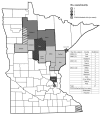Powassan virus encephalitis, Minnesota, USA
- PMID: 23017222
- PMCID: PMC3471639
- DOI: 10.3201/eid1810.120621
Powassan virus encephalitis, Minnesota, USA
Abstract
Powassan virus (POWV) is a rare tick-borne agent of encephalitis in North America. Historically, confirmed cases occurred mainly in the northeastern United States. Since 2008, confirmed cases in Minnesota and Wisconsin have increased. We report a fatal case of POWV encephalitis in Minnesota. POWV infection should be suspected in tick-exposed patients with viral encephalitis.
Figures


Comment in
-
Powassan virus encephalitis, Minnesota, USA.Emerg Infect Dis. 2013 Apr;19(4):686. doi: 10.3201/eid1904.121651. Emerg Infect Dis. 2013. PMID: 23750562 Free PMC article. No abstract available.
References
-
- Artsob H. Powassan encephalitis. In: Monath TP, editor. The arboviruses: epidemiology and ecology. Boca Raton (FL): CRC Press; 1989. p. 29–49.
Publication types
MeSH terms
Substances
LinkOut - more resources
Full Text Sources
